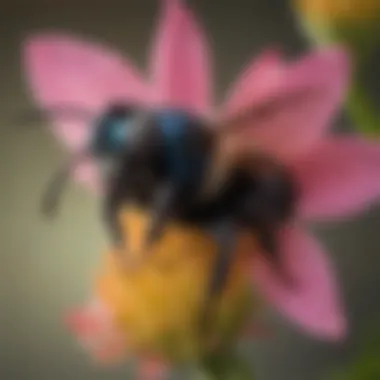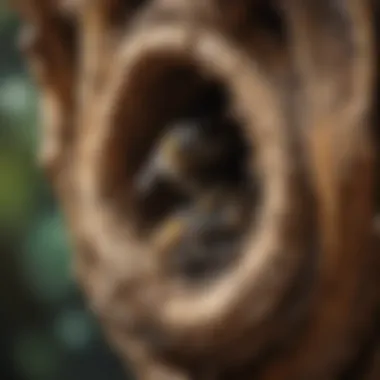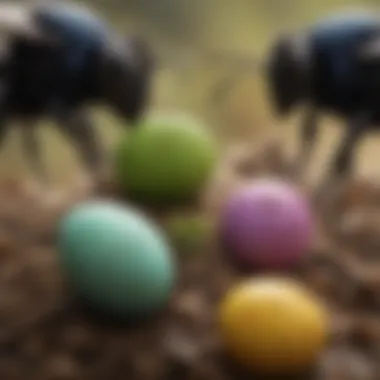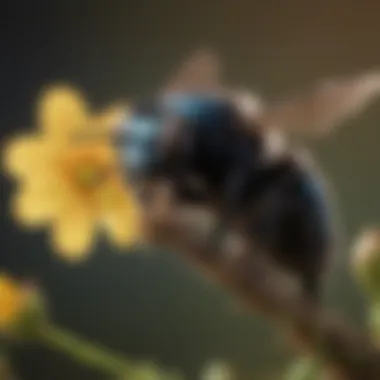Understanding Carpenter Bees: Nesting Habits and Ecology


Intro
Carpenter bees are remarkable insects that play an essential role in our ecosystems. Their unique behavioral patterns and nesting habits draw significant interest among those who study wildlife. Their ecological importance cannot be overstated, particularly in the context of pollination. However, the interaction between these bees and human environments often raises questions and concerns. This article seeks to illuminate the world of carpenter bees by exploring their fascinating characteristics, habitats, and the implications of their presence around human structures.
Fascinating Facts About the Animal
Unique Characteristics
Carpenter bees, known scientifically as Xylocopa, possess bodies that resemble bumblebees but can be distinguished by their shiny, hairless abdomens. These bees vary in size, with some species reaching up to 2.5 centimeters in length. Their coloration ranges from black to metallic blue or green, depending on the species. Though generally docile, male carpenter bees can be territorial, patrolling around their nesting sites to defend their space.
Extraordinary Abilities
Carpenter bees are excellent pollinators, contributing to the fertilization of various plant species. Their ability to vibrate their bodies while perched on flowers—known as buzz pollination—enhances their efficiency in accessing nectar and pollen. This ability is particularly beneficial for certain plants, like tomatoes and blueberries, which require this method for optimal pollination.
"Carpenter bees are not just phenomenal pollinators; they are essential players in maintaining the ecological balance."
Behavior and Habitat
Natural Habitats
Carpenter bees prefer to establish nests in wood, which is essential for their lifecycle. They typically seek out soft, untreated wood and will excavate tunnels to create their nesting sites. Common locations include decks, fences, and the siding of buildings. In natural environments, they also nest in dead trees or decaying logs, exploiting the easier access to softer wood.
Social Structures
While carpenter bees are largely solitary, some species exhibit a degree of social behavior. Females typically create nests without assistance from the males. However, they can form loose aggregations in certain environments. These aggregations are not colonies in the true sense, as each female operates independently, establishing her own nest and attending to her offspring.
Recent Scientific Discoveries
Latest Research Findings
Research into carpenter bees has revealed significant insights into their role as pollinators and the challenges they face. Studies show that changes in land use and habitat loss significantly impact their population. Conservation efforts are being explored to protect their nesting habitats, while enhancing public understanding of their ecological contributions.
Breakthroughs in Animal Biology
Recent breakthroughs in bee biology highlight the genetic and behavioral adaptations of carpenter bees in urban environments. Understanding these adaptations can aid in developing strategies for coexistence with humans while fostering a healthy ecosystem.
Cultural Significance
Animals in Folklore
Carpenter bees feature prominently in various folk tales and traditions across cultures. Often seen as symbols of hard work and diligence, they remind us of the important roles that insects play in our lives. Their industrious nature has inspired admiration and respect in many narratives.
Influence on Art and Literature
The portrayal of bees in art and literature reflects their significant presence in human culture. They are often depicted as symbols of community and harmony. This artistic representation underscores the need to appreciate and understand these creatures beyond their ecological roles.
Carpenter bees are crucial for the balance of ecosystems, contributing significantly to the reproductive cycle of various plants.”
In addition, their boring activities contribute to wood decay, which can foster habitats for other species. Understanding the role of carpenter bees enriches our appreciation of biodiversity and the interconnectedness of life.
Nesting Preferences of Carpenter Bees
Nesting preferences are a critical aspect of carpenter bee behavior. Understanding where these bees choose to nest sheds light on their biology and their interactions with ecosystems and human environments. Carpenter bees are solitary insects, and their nesting choices can impact both ecological balance and economic activities. By examining their nesting habits, we can learn to support these important pollinators while minimizing potential conflicts with human systems.
Types of Nesting Sites
Carpenter bees are selective about their nesting locations. They prefer sites that offer shelter and protection from predators and harsh weather. Common nesting sites include:
- Wooden structures: Carpenter bees often burrow into wooden surfaces, particularly untreated softwoods like pine and cedar.
- Dead trees: Trees that are decaying can provide optimal nesting conditions, as they are easier to excavate.
- Natural cavities: These bees may also make use of pre-existing holes created by other insects or natural wear in wood.


The selection of nesting sites is influenced by the surrounding environment. Urban areas can pose challenges due to a lack of suitable nesting materials. Understanding these preferences can assist in preserving habitats required by carpenter bees.
Preferred Materials for Nesting
Carpenter bees exhibit a strong preference for specific materials. Their nesting requires wood that is both soft and relatively dry. The preferred types include:
- Untreated wood: Untreated wood is favored as it is easier to bore into. Treated woods are less desirable due to their chemical content.
- Old wood: Weathered and old wood not only has softer texture but also often has better moisture content, creating a suitable nesting medium.
- Certain plant fibers: Occasionally, they utilize plant materials such as bamboo for nesting, although wood remains predominant.
It is important to acknowledge that the availability of these materials varies geographically. Areas rich in native trees can support larger populations of carpenter bees, while urban areas may not provide adequate material, thus impacting bee presence.
Nesting Behavior Patterns
The nesting behavior of carpenter bees is intricate. Unlike many other bee species, these bees do not create hives. Instead, females excavate passages in wood to lay their eggs. Key behavior patterns include:
- Solitary nature: Each female establishes her own nest, unlike social bees which work collectively.
- Nesting architecture: The nest is usually a series of tunnels that branch out, creating separate chambers for each egg. The female will cover each chamber with a mixture of pollen and nectar as food for her larvae.
- Seasonal activities: Nesting primarily occurs in spring, coinciding with the availability of flowers. After mating, female carpenter bees focus on building nests and laying eggs.
Understanding these behaviors is crucial for appreciating how carpenter bees interact with their environment and the needs that arise during their nesting process.
By gaining insight into their nesting preferences, we can better appreciate carpenter bees and recognize their importance in maintaining biodiversity.
Lifecycle of Carpenter Bees
The lifecycle of carpenter bees is a critical aspect that underscores their biology and ecological role. Understanding this cycle provides insights into their behavior, allows for effective management strategies, and helps appreciate their significance in ecosystems. Each stage of their lifecycle reflects their adaptability and ecological niche, illustrating how they interact with their environment and, consequently, how humans interact with them.
Mating and Reproduction
Carpenter bees exhibit unique mating behaviors. Males typically patrol specific areas, engaging in what is known as territorial behavior, to attract females. Courtship might involve aerial displays and chasing. Once a female selects a mate, they engage in copulation. After mating, the female seeks a suitable nesting site, often using previously established burrows or drilling into untreated wood to create new ones.
The female lays eggs inside these nests, providing a food source in the form of nectar and pollen for the larvae. This process not only ensures the survival of the offspring but also plays a role in pollination, as carpenter bees help transfer pollen between flowers.
Life Stages Explained
The lifecycle of a carpenter bee consists of four main stages: egg, larva, pupa, and adult. After the female lays her eggs, they hatch into larvae. At this stage, they feed on the stored pollen and nectar. This diet is crucial for their growth. The larvae undergo several molts while growing, entering a pupal stage where they develop into adults. This metamorphosis is essential for the development of distinct physical characteristics that differentiate male and female bees.
As adults, carpenter bees have a short active lifespan, typically ranging from several months to a year. Their effective life cycle allows them to adapt to seasonal changes and available resources, influencing their population dynamics.
Duration of Lifecycle Events
The duration of lifecycle events can vary significantly based on environmental conditions, such as temperature and food availability. Generally, the entire lifecycle from egg to adult can take several weeks to months. Optimal conditions can expedite this process, while adverse conditions can prolong it. For instance, cooler temperatures or food scarcity can delay growth and development.
Understanding these durations is critical for effective conservation and management of carpenter bee populations. It emphasizes the importance of monitoring environmental factors that may impact their lifecycle events.
Identifying Carpenter Bees
Identifying carpenter bees is a critical aspect for understanding their behavior and interactions with humans and the environment. Recognizing the specific traits and patterns of these insects can help mitigate any potential conflicts and promote their ecological contributions. Knowledge of their physical characteristics, similarities to other species, and behavioral cues is essential for anyone interested in studying or managing these important pollinators.
Physical Characteristics
Carpenter bees are notable for their distinct appearance. They typically have a robust, cylindrical body that is often shiny and can appear black or yellow, depending on the species. The male and female carpenter bees exhibit sexual dimorphism. Males usually have a fuzzy, more colorful face with a lower chance of stinging because they lack a stinger. Females are somewhat larger and are the ones responsible for nesting. The smooth, shiny abdomen of a female distinguishes them from bumblebees, which have more hairy abdomens. The average size ranges from 1/2 inch to 1 inch in length. Awareness of these characteristics aids in proper identification, contributing to effective management strategies and appreciation of their ecological role.
Similar Species
In the field of entomology, distinguishing carpenter bees from other similar species can be tricky. Bumblebees, for instance, share some physical traits but can be distinguished by their fuzzy bodies and different nesting behaviors. While carpenter bees prefer to nest in wood, bumblebees often use preexisting cavities in the ground. Furthermore, the two genera are separated by their behaviors and life cycles. Understanding these differences is crucial for both enthusiasts and professionals in wildlife biology, as misidentifications can lead to erroneous assumptions about a species’ ecological role and management needs. The clear awareness of similar species can minimize confusion and support learning about plant-pollinator interactions.
Behavioral Cues for Identification
Behavioral cues provide additional context for identifying carpenter bees. Carpenter bees exhibit a distinct hovering behavior, often seen around nesting sites or flowering plants. Males can be particularly aggressive in defending a territory, performing aerial displays that signal their presence. However, they usually do not pose a threat, as they lack stingers. Observing these behaviors can assist in determining not only the presence of carpenter bees but also their role in a specific ecosystem.
Key Observation: Understanding the nuances in behavioral traits is beneficial for identifying these insects and their interactions within various environments.
Recognizing carpenter bee nesting behavior, such as drilling holes into wood or creating tunnels, is another important cue. These behaviors indicate not only identification but also can inform management practices, particularly in preventing damage to wooden structures.


Ecological and Economic Importance
Carpenter bees play a vital role in their ecosystems, influencing both biological and economic facets of their surroundings. Understanding this significance is crucial, especially for those interested in conservation, agriculture, and biodiversity.
Pollination Role
Carpenter bees are key pollinators in various ecosystems. They have a unique method of pollination. Unlike honey bees, carpenter bees engage in sonication. This technique involves buzzing at a specific frequency, which helps release pollen from flowers. Many plants, especially those in the mint family, benefit from this approach.
Their ability to pollinate is not merely incidental. Approximately 30% of the food crops humans rely on are dependent, at least in part, on pollinators like carpenter bees. This includes fruits, vegetables, and nuts. We need to understand the impact of their decline on food security. Without these important pollinators, agricultural yield may suffer considerably.
Impact on Agriculture
Agricultural systems benefit enormously from carpenter bees’ activities. Their effective pollination contributes to higher quality and quantity of fruits and vegetables. For instance, crops such as tomatoes and blueberries show improved yields when carpenter bees are present.
Farmers can view carpenter bees as allies rather than pests. Their natural behaviors enhance pollination across vast areas, allowing for a more sustainable approach to agriculture. Some studies have shown that regions with active populations of carpenter bees report less need for artificial pollination methods. This translates to lower operational costs for farmers.
- Reduced Chemical Use: Carpenter bees aid natural pollination, leading to a decrease in reliance on chemical pollinants.
- Economic Value: Improve crop yields provide a more stable income for farmers.
Contributions to Biodiversity
Carpenter bees contribute significantly to biodiversity. By facilitating plant reproduction, they help maintain genetic diversity within plant populations. This biodiversity is crucial, as it supports ecosystem resilience. A healthy ecosystem can adapt better to changes such as climate fluctuations.
Moreover, the presence of these bees can indicate a healthy environment. Their absence may signal ecological issues that require attention. Thus, their conservation is not just beneficial; it is essential for the well-being of various species, including humans.
Important Note: Preservation of carpenter bees and their habitats promotes overall ecological balance, impacting not just plants but whole animal populations that rely on those plants for sustenance.
In summary, the ecological and economic importance of carpenter bees cannot be overstated. Their integral role in pollination, agriculture efficiency, and biodiversity supports broader environmental health and sustainability. As we continue to discuss these bees, it becomes clear that their well-being directly correlates to ours.
Human Interaction with Carpenter Bees
Carpenter bees play a complex role in human environments. Understanding this interaction is key for both conservation and management. These bees not only contribute to pollination but also have the potential to cause structural damage if not managed properly. Building a balanced relationship with carpenter bees can enhance biodiversity while also protecting our properties.
Positive Interactions
Carpenter bees are proficient pollinators. They are often attracted to flowering plants, which include fruit trees and ornamental flowers. This makes them essential for gardens and crops. Their ability to pollinate effectively contributes to the ecological balance and supports food production.
Additionally, observing carpenter bees can be an educational experience. Families and individuals can learn about the importance of these insects in ecosystems. Encouraging their presence in gardens can lead to increased pollination. Furthermore, fewer chemical pesticides are necessary when carpenter bees fulfill their role.
- Pollination Benefits:
- Educational Value:
- Enhanced gardening and crop yields.
- Natural pest control when bugs are balanced in an ecosystem.
- Learning opportunities for children and adults.
- Encouragement of interest in entomology and environmental science.
Challenges and Conflicts
Despite their benefits, carpenter bees can create conflicts with humans. Their nesting habits often lead them to drill into wooden structures, causing damage. Wooden decks, fences, and eaves are common targets for these bees. This can be problematic for homeowners. To mitigate these issues, awareness and preventive measures are necessary.
Another conflict arises from misunderstanding. Many people fear bees in general, leading to negative perceptions of carpenter bees. This fear can result in harmful actions towards these creatures, which undermines their ecological contribution.
Understanding and appreciating carpenter bees can reduce fear and promote coexistence.
Management Strategies
Managing carpenter bee populations involves a blend of prevention and education. Here are some strategies:
- Physical Barriers: Cover untreated wood, as this is the primary target for nesting.
- Regular Inspections: Check for signs of nesting in wooden structures to catch issues early.
- Plant Choice: Favor flowers that attract these bees, promoting pollination while keeping them away from potentially problematic areas.
- Educating the Public: Informing neighbors about carpenter bee benefits can foster community-wide understanding, which can protect these bees in our environment.
Preventing Carpenter Bee Infestations


Preventing carpenter bee infestations is critical for maintaining the integrity of wooden structures and ensuring ecological balance. Carpenter bees, while beneficial for their pollination abilities, can cause significant damage to untreated wood. Their nesting habits can lead to structural weaknesses in buildings and gardens. Awareness of their behavior is essential for effective prevention strategies.
Monitoring Nesting Activity
To protect structures from carpenter bees, it is vital to monitor their nesting activities. Observing their behavior can reveal nesting sites and prevent large infestations. Carpenter bees are often seen hovering around wood surfaces during the day. They typically prefer unpainted or weathered wood over painted surfaces. By regularly inspecting these areas, homeowners can detect early signs of activity, such as small, round holes in wood, which are indicative of nesting.
Simple observational tools can assist in tracking these insects. Installing a bee monitoring board painted in a contrasting color can draw their attention, allowing for easier identification and assessment of their presence. Observation should be paired with knowledge of their lifecycle, as comprehensive monitoring involves being aware of the time of year when nesting is most active. For instance, early spring is when these bees emerge from hibernation and begin their nesting process. Therefore, increased diligence during this period is advisable.
Construction Considerations
When building or renovating structures, certain considerations can help minimize the risk of carpenter bees establishing nests. Using alternative materials, such as composite woods or pressure-treated lumber, can deter these bees since they prefer untreated wood for nesting. Applying a quality paint or sealant to wooden surfaces effectively creates a barrier that is less attractive for nesting.
Furthermore, contractors and homeowners should focus on construction design elements that deter bees. Avoiding exposed wooden beams or untreated wooden fences can restrict nesting opportunities. Adding protective features such as overhangs can also limit access to horizontal surfaces that are attractive to these bees. Regular maintenance of garden areas and wooden structures will ensure that any potential nesting sites are identified and treated swiftly.
Chemical and Non-Chemical Solutions
There are both chemical and non-chemical solutions to manage carpenter bee populations effectively. Non-chemical methods are often preferred due to their environmental impact. Using natural deterrents, such as essential oils, can keep carpenter bees away from specific areas. For example, peppermint or citrus oil can be sprayed in areas where nesting is suspected. Such approaches can provide effective barriers without harming beneficial pollinators.
However, if infestations are severe, a combination of non-chemical methods with more direct interventions may be required. Chemical insecticides can be effective when used according to guidelines. Applying these products directly into the nests during the evening when bees are less active can minimize harm to other insects. It is crucial to consider targeted applications rather than broad spraying to protect the overall ecosystem. Always follow safety instructions when dealing with chemicals to ensure both human and environmental safety.
Conservation of Carpenter Bees
Understanding the conservation of carpenters bees is key in this discussion. Conservation efforts are essential not only for maintaining their presence but also for sustaining the environment they inhabit. Carpenter bees play an important role in pollination, contributing to the health of various ecosystems and agricultural systems. Protecting these bees is crucial as their population faces significant threats.
Threats to Populations
Several threats impact the populations of carpenter bees. Some of the most pressing concerns include:
- Habitat Loss: Urban development and land-use changes lead to diminishing natural habitats. This reduction in suitable nesting sites makes survival challenging.
- Pesticides: The widespread use of chemical pesticides in urban and agricultural areas adversely affects bee populations. These substances can be toxic, harming not only bees directly but also their food sources.
- Climate Change: Alterations in climate patterns can lead to mismatches in the timing of flowering plants and bee activity. Increased temperatures and erratic weather patterns may affect their lifecycle and reproductive success.
Diminishing populations of carpenter bees can disturb ecological balance. This, in turn, affects numerous plant species that rely on these bees for pollination.
Importance of Conservation Efforts
Conservation efforts for carpenter bees are vital for multiple reasons:
- Ecosystem Health: Conserving these bees promotes pollination. Increased pollination benefits plant communities, leading to healthier ecosystems.
- Agricultural Sustainability: Many crops depend on bees for proper pollination. Conservation initiatives can lead to enhanced crop yields, benefiting agricultural economies.
- Biodiversity: Protecting carpenter bees contributes to the wider biodiversity. Each species plays a specific role in their ecosystem, which is pivotal for overall environmental stability.
Supporting conservation efforts can lead to a lasting impact on both natural habitats and agricultural systems.
Community Engagement in Conservation
Engaging the community in conservation initiatives is a fundamental aspect of maintaining carpenter bee populations. There are several ways communities can contribute:
- Educational Programs: Promoting awareness about the significance of carpenter bees can foster community respect for these insects. Workshops and informational sessions can be effective tools.
- Creating Habitats: Community members can plant native flowers that serve as foraging sources. Providing natural nesting spaces can also aid these pollinators.
- Supporting Local Regulations: Advocating for policies that limit pesticide use and promote organic farming can protect carpenter bees.
- Volunteer Opportunities: Encouraging citizens to take part in local conservation projects can enhance community bonding and promote a shared responsibility towards the environment.
By bringing together more community members, conservation efforts for carpenter bees become a collaborative journey, ensuring their future and the ecological health of their habitats.
Epilogue
The discussion around carpenter bees offers significant insights into their behaviors, ecological roles, and the interactions they have with human environments. Understanding these aspects is crucial not only for researchers and environmentalists but also for families and communities that may encounter these pollinators. Through this exploration, we realize the dual nature of carpenter bees: while they can pose challenges, they also bring immense benefits to ecosystems.
Summary of Key Points
To synthesize the information presented:
- Carpenter bees are essential pollinators, playing a vital role in the reproduction of numerous plant species.
- Their nesting habits are unique, often favoring wood and other fibrous materials, which can lead to structural concerns for humans.
- The lifecycle of carpenter bees involves distinct stages from mating to maturation, highlighting the importance of seasonality in their activities.
- They contribute significantly to biodiversity, supporting various ecological processes that benefit both nature and agriculture.
- Effective management strategies can promote coexistence, allowing communities to benefit from their pollination services while mitigating potential property damage.
This summary emphasizes the need to balance the coexistence of humans and carpenter bees, acknowledging their ecological value while being aware of their potential to create conflicts in urban or suburban settings.
Future Directions for Research
Future research on carpenter bees should aim to deepen our understanding of their ecological contributions and the challenges they face, especially in rapidly changing environments. Areas of focus could include:
- Impact of Climate Change: Investigating how altering temperatures, precipitation patterns, and seasonal shifts affect carpenter bee populations and behaviors.
- Interaction with Pesticides: Analyzing the effects of chemical treatments in agriculture on carpenter bee health and pollination efficacy.
- Habitat Restoration: Exploring strategies for creating environments that support carpenter bee nesting and foraging, benefiting entire ecosystems.
- Public Awareness Campaigns: Developing educational programs to promote awareness about carpenter bees, emphasizing their importance and how to manage interactions positively.
Overall, continued research is essential to enhance our understanding of carpenter bees, ensuring that their role in ecosystems is not only recognized but valued, leading to informed decisions about their conservation and management.







